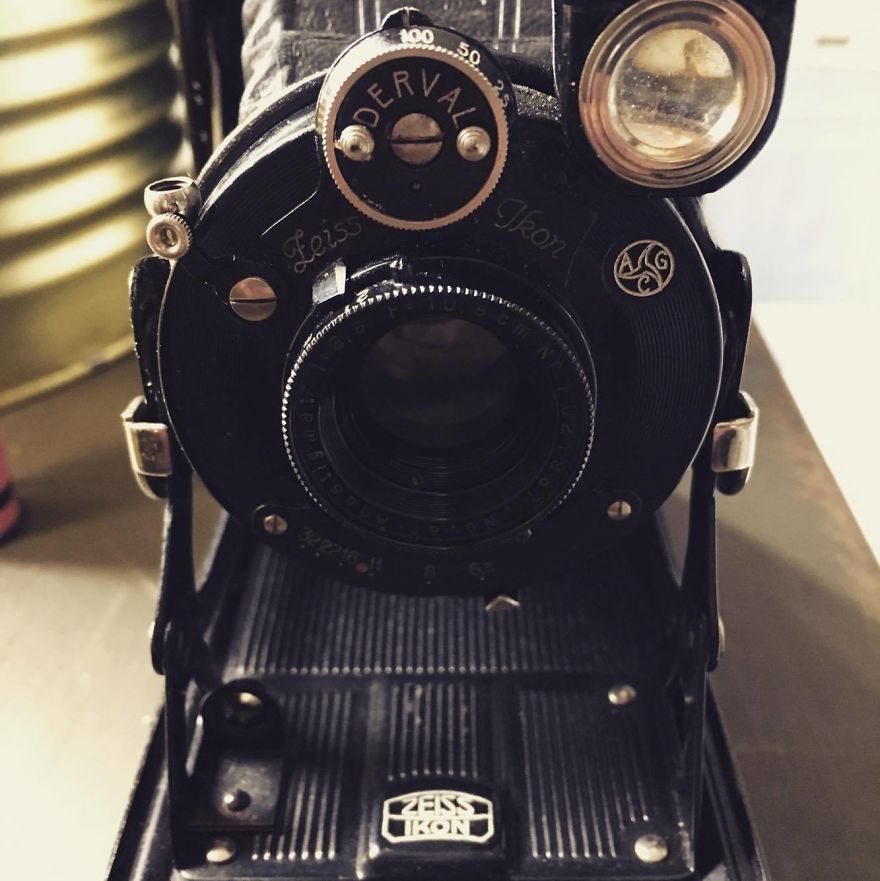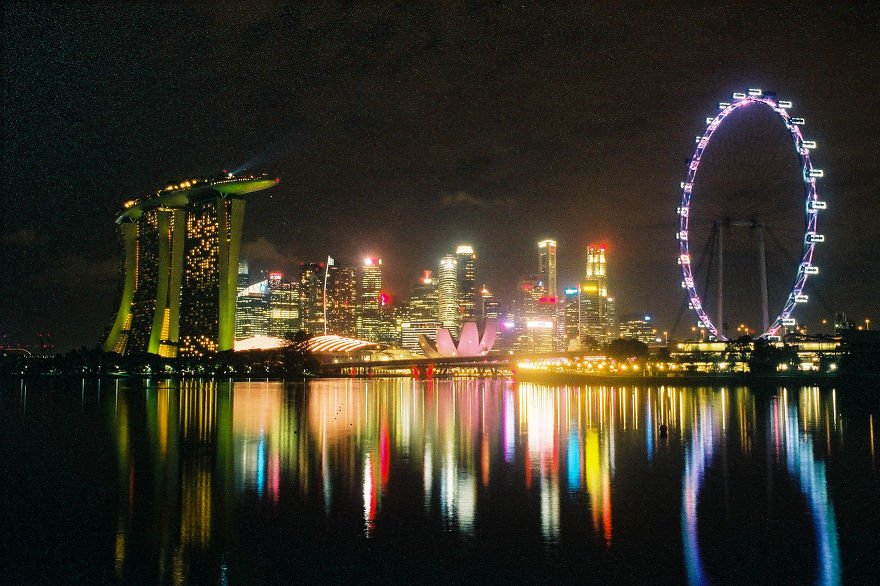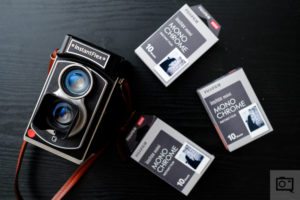
When you use DPReview links to buy products, the site may earn a commission. The Pentax 17 is the first Pentax film camera in two decades. It's a half-frame camera, meaning it captures two vertical images instead of a single horizontal one on each frame of film.
The number '17' in the name refers to the width of the 17 x 24mm frame that it captures on standard 35mm film.
Key features and specifications
Half-frame image capture (17 x 24mm)
37mm (equiv) FOV F3. 5 lens
Zone focusing system with 6 zones
Circular leaf shutter (F3. 5-16)
Built-in flash (6m/20ft at ISO100)
Optical tunnel viewfinder with frame lines
Exposure from 1/350 sec to 4 sec (+ Bulb)
Supports films from ISO 50 to ISO 3200
The Pentax 17 will be available in late June at a suggested retail price of $499. A bundle that includes one roll of Ilford HP5 Plus 400 B&W film, one roll of Kodak UltraMax 400 color film, two film processing coupons and a two-year extended warranty (for a total of three years) will sell for $599.
Buy now:
$499 at B&H Photo$499 at AdoramaWho it's for
Before discussing the camera's features and performance, it's worth examining who the Pentax 17 is aimed at. Ricoh says it's seen a renewed interest in film, particularly among young people, an important demographic for any manufacturer. It believes many photographers who take pictures with smartphones want to do something more creative. This includes people who haven't shot film before and some who haven't shot film in a long time.
With that context in mind, Ricoh tells us it chose the half-frame format for two important reasons. The first is to mitigate costs; film may be experiencing a resurgence, but prices remain high, particularly when you include both film and processing. By doubling the number of frames on each roll of film, it effectively cuts the cost-per-frame in half.
"Pentax says it wants to keep the camera's learning curve relatively simple, making it easier for first-time film shooters to get the desired results without requiring much experience. "
The second is that the vertical format more closely aligns with the shooting style many people have adopted for sharing photos on social media platforms.
Additionally, Ricoh says it wants to keep the camera's learning curve relatively simple, making it easier for first-time film shooters to get the desired results without requiring much experience. As a result, the camera uses programmed exposure modes rather than offering a fully manual shooting experience.
That's maybe a roundabout way of saying that if you're looking for a fully manual, full-frame 35mm film camera, the Pentax 17 isn't it. However, that doesn't mean you can't have a lot of fun shooting it.
Body and design
The Pentax 17 is essentially a modern point-and-shoot camera, though it's a well-built one. It weighs 290g (10. 2 oz) without film or battery, and the top and bottom plates are made of magnesium alloy. Much of the middle is made of plastic. Consistent with the camera's compact style, the grip is relatively small.
In an homage to previous Pentax cameras, the Pentax 17 includes several features borrowed from, or inspired by, earlier Pentax models, one of which is visible on the front: the number 17 in the camera's logo uses the same font for the digits as Pentax 6x7 cameras from years past.
Another throwback is visible on the top of the viewfinder, with the Asahi Optical Company logo appearing above the Pentax branding. You'll also find the film plane indicator and the words 'Film Camera' here.
The camera's mode dial is divided into three color-coded sections: blue, white and gold. The blue section has a single Auto mode, in which the camera will make all exposure decisions, including whether or not to fire the flash. The white section includes Program, Slow-speed, bulb modes, and a Bokeh mode that forces the leaf shutter to remain at its widest possible aperture. Selecting any of the modes in the white section turns off the flash.
In contrast, selecting any mode in the gold section will force the flash to fire. It includes a standard Program mode (with flash sync) and a Slow-speed sync mode that allows the shutter to remain open long enough for ambient light conditions.
An exposure compensation dial with a range of ±2EV in 1/3 stop increments provides an added degree of control in situations that could fool the camera's auto exposure metering, such as taking photos in the snow.
The camera's shutter button, which is based on the one from the Pentax KP DSLR, is surrounded by the on/off switch. Alongside it, you'll find the film advance lever and frame counter. We're told the film winding mechanism is based on the one from the Pentax Auto 110, and the frame counter goes all the way to 72, the maximum number of photos you can take using a roll of 36-exposure film.
The built-in flash also comes from the Pentax KP, though it's mounted in front instead of using a pop-up mechanism. It's rated for 6m (20ft) at ISO 100.
When loading film, you'll need to set the ISO using the ISO dial, which is released by a small black button to the right of the dial. The camera supports films within the ISO range of 50-3200.
Inside the ISO dial is the film rewind crank, another throwback: It's based on the crank from the Pentax LX, an SLR released in 1980, and we're told the white arrow markings on the crank are designed to mimic the Pentax Spotmatic SP.
The back of the camera includes a 2. 5mm jack that works with the Pentax CS-205 cable release. To enhance the film experience, there's even a frame to hold the top flap of the film box to remind you of what film is in the camera. Finally, the bottom of the camera has a tripod socket and the film rewind release button.
Lens
The Pentax 17 uses a 25mm F3. 5 lens with a leaf shutter, but owning to the camera's half-frame format, it has an effective 37mm focal length in equivalent terms. It's supposed to be based on the lens in the Pentax Espio Mini from 1994, and like that camera, it uses a triplet design that features three elements in three groups. It has been updated to include Pentax's modern HD coating. The smallest aperture is F16.
The lens employs a zone focus system with six available presets: 0. 25m, 0. 5m, 1. 2m, 1. 7m, 3m (0. 82ft, 1. 7ft, 4ft, 5. 6ft, 10ft) and infinity. Zones are selected using icons along the top of the lens, with index marks in meters and feet also available below the lens.
The lens includes a 40. 5mm filter thread, and since the light meter is located on the front of the lens, it should meter accurately even with a filter attached.
Viewfinder
The most obvious thing you'll notice when looking through the viewfinder is that it's vertical, owing to the camera's half-frame design.
The viewfinder is a simple optical tunnel design. It includes two sets of frame etchings, one for regular photos and one for shooting in macro mode, which corrects for parallax when the camera is close to the subject.
A pair of LED lights sits to the right of the viewfinder to indicate conditions such as insufficient light (which could also indicate that the lens cap is still attached), that the film lever needs to be wound before you can shoot the next frame, or to remind you that you're in macro mode.
"The most obvious thing you'll notice when looking through the viewfinder is that it's vertical, owing to the camera's half-frame design. "
Helpfully, a pass-through in the viewfinder allows you to see which zone focus icon is currently selected. This allows you to select the focus zone without removing the camera from your eye.
Battery
The Pentax 17 may be the first Pentax camera introduced in quite some time not to include a rechargeable battery, opting for a 3V CR2 lithium battery instead.
According to the spec sheet, a battery should last through 10 rolls of 36-exposure film when using flash for 50% of the photos. However, a Ricoh representative told us that, in practice, most users will likely get double this number if they do not use the flash so frequently.
In use
In many ways, shooting the Pentax 17 is reminiscent of using an old point-and-shoot film camera. But not quite.
Many point-and-shoot film cameras from the last couple of decades of the film era did as much as possible to get film out of users' way: features like auto-winding to the first frame, automatic film advance between frames, and auto rewind at the end of a roll of film were commonplace. And, of course, most were autofocus. In essence, in an era where every camera shot film, most point-and-shoot cameras aimed to make it possible for people just to point and shoot.
Sample galleryThis widget is not optimized for RSS feed readers. Click here to open it in a new browser window / tab.
Pentax 17 sample gallery
Photos captured using Kodak Ektar 100 film and processed by The Darkroom with 'Enhanced' scanning [2048 x 2905 resolution)
The Pentax 17 takes a hybrid approach. It feels like a point-and-shoot but provides enough tactile cues to ensure that you engage with the film experience. Manually advancing the film to the first frame, cranking the film advance lever between shots, and manually rewinding at the end of the roll are all part of the process. I rather enjoyed the simple action of cranking the film advance lever and using it to anchor my thumb when shooting. As a former film shooter, it felt very natural.
Similarly, zone focusing requires you to stop and evaluate the scene. It's been a while since I've shot using zone focusing, and it took me a little time to get into the groove, but it provided an enjoyable balance between needing to stop to think about my settings and a casual point-and-shoot experience. Zone focusing is pretty simple, and I expect most users will get pretty good at it after shooting a couple of rolls of film.
Kodak Ektar 100
Photo: Dale Baskin
The thing that's going to jump out to many experienced photographers will be the vertical viewfinder. This can be a bit jarring in a world where most cameras default to landscape view, but I mostly forgot about it within a few minutes and just enjoyed shooting. Pentax anticipates selling many of these cameras to people who came of age shooting on smartphones, and I expect many of those users will feel right at home with the vertical arrangement.
Overall, the camera handles well. The small grip provides a good balance between handling and appearance, and the controls are logical and comfortably laid out. Turning the focus ring on the lens feels less precise than I'd like – I wish it would more definitively click into place when switching between zones – but it's not a showstopper.
The half-frame approach has one very tangible benefit: with up to 72 exposures on a roll of film, you're likely to spend less time watching the film counter and more time enjoying the photography experience.
Image quality
Considering the Pentax 17's half-frame format, it shouldn't come as a surprise that it doesn't deliver the same image quality as the larger negatives from a standard 35mm camera (similar to what we see with different sizes of digital sensors). Let's stipulate that the Pentax 17 isn't a camera you're going to buy if absolute image quality is your top priority. Instead, it's a camera you buy because you're looking for a particular type of shooting experience.
Overall, image quality met my expectations. The lens isn't as tack-sharp as the more modern designs found on recent digital cameras, but even if it were, chances are pretty good it would out-resolve most of the film you're likely to put in the camera. Generally speaking, image quality reminds me of the results you would get from a typical point-and-shoot film camera, which isn't too surprising considering the lens' heritage.
Kodak Ektar 100
Photo: Dale Baskin
One of the biggest factors that will impact image quality isn't the camera itself but the film you use. During my test period with the camera, I used Kodak Ektar 100 film, which produces relatively high contrast and vivid colors. In retrospect, it probably wasn't the best film stock for a sunny summer day with a lot of contrast, but that's what I put in the camera. As a result, some of my photos include blown highlights and dark shadows that likely wouldn't have occurred had I used a film with less contrast.
However, that's part of the film photography experience: sometimes, you just have to shoot whatever film happens to be in your camera.
How the film is developed can also be a factor. Our film was processed and scanned by a commercial lab, The Darkroom, and included 'Enhanced' scans that measure 2905 x 2048 pixels.
I expect most people who seek out the Pentax 17 will do so to share images on social media or make small prints rather than ordering huge enlargements to hang over the fireplace. For those uses, image quality is acceptable. What's probably more important to these users is the ability to create images with a distinct look different from the highly processed smartphone images most people are used to seeing.
Conclusion
When considering the Pentax 17, it's essential to manage expectations. Understandably, some design choices, particularly the decision to go with a vertical-first, half-frame format, have been polarizing within the photography community, especially among long-time photographers. In this case, it's important to consider the product's target audience.
Film continues to sell, in part due to younger photographers who want to experiment with film photography. It's a logical demographic for Pentax to go after, and it allows the company to start building relationships with a different generation of users. In that context, a half-frame camera that defaults to vertical shooting makes some sense.
Kodak Ektar 100
Photo: Dale Baskin
However, don't be misled into thinking the Pentax 17 is only for the Instagram crowd. Sometimes, photography is simply about having fun, and I had a lot of fun using the camera. In fact, one of the things I enjoyed most was the half-frame format. Anyone who has shot film knows that part of the experience is that brief moment of anxiety you experience every time you press the shutter button, hoping each photo is worth the incremental expense. Watching the frame counter tick up and knowing you can go all the way to 72 removes some of that stress.
And those expenses are real. The Darkroom, the commercial lab that processed and scanned our photos, charges around $20 to process and scan a roll of 35mm film from a half-frame camera, which includes online delivery of the scans and negatives returned by post. Adding a set of prints increases that cost by around $10. Prices will vary between labs, but this gives you a ballpark idea of the costs.
At $499, the Pentax 17 will be more than an impulse buy for most people. However, some used point-and-shoots, including the Pentax Espio Mini, routinely sell on the used market for around $250. From that perspective, a new camera with a warranty and a company to back it up could be attractive to buyers who prefer not to roll the dice on used gear.
Should you buy it? If you're the type of person who hasn't shot film before, or maybe not in a long time, the Pentax 17 is a good entry point to get the film shooting experience. However, there are a lot of great point-and-shoot film cameras available on the used market, too, though it's worth noting that many of these have seen their value increase in recent years and may not be the bargain they once were. But, if the idea of a half-frame, semi-manual camera appeals to you, and your expectations for image quality are reasonable, the Pentax 17 is a good option.
What we like
Classic looking design
Good controls and handling
Good balance between manual and automatic control
What we'd like to see improved
Some plastic parts don't live up to overall build quality
More precise zone-focus ring
Price
2024-6-25 16:00













